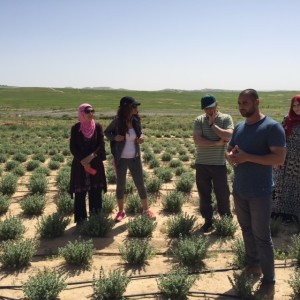Environmental Justice Course Visits S. Israel
On March 11 and 12, participants in the long-term environmental justice change agents course visited locations in southern Israel as part of a tour conducted by the School for Peace.
Wadi Atir
On Friday, participants first went to Wadi Atir, an ambitious educational eco-social tourism farm project launched jointly by the nearby Hura municipality and the US-based Sustainability Laboratory , with a number of partner organizations. It combines traditional Bedouin farming methods with modern technology and sustainability principles. The project ensures that the by-products of one activity are used to assist with another activity, ensuring minimal waste. The project’s ecosystem restoration component was recognized as an important demonstration globally, at the Twelfth Session of the Conference of the Parties (COP12) at the United Nations Convention to Combat Desertification.
Darijat
Next, participants had lunch at Darijat, a traditional Bedouin village. This village was founded by one family and expanded as time went on, though it is still primarily composed of that family. The village is powered through solar energy as it is not connected to the national electric grid. Despite this limited access to resources, the majority of residents are employed and highly educated, with little to no crime, drug abuse or similar issues.
Umm al-Hiran
The final Friday excursion was to Umm al-Hiran village. The villagers have lived at the site since the 1950s. They were settled there by military order, after the state forcibly evacuated them from another location in the Negev. In what was originally an area of wilderness, they gradually built for themselves a village. Despite a complete lack of government services, they have managed by providing their own alternative solutions like solar power. They have also ensured that their children receive proper education. Today, the village is engaged in a struggle as the state wishes to evacuate all of the residents, destroy the village and replace it with a new planned Jewish town to be named Hiran. It is important to join the struggle to prevent this injustice.
Kibbutz Lotan and Timna Park
Participants concluded the day by traveling to Kibbutz Lotan where they stayed overnight. Friday evening, participants reflected on what they had seen during the day and how it affected them. Saturday morning included a tour of the kibbutz and its many ecological attractions.
The other Saturday morning excursion was to Timna Park, where they explored the various natural ruins and what are believed to be the world’s first copper mines. Participants also learned of the role of the area in ancient Egyptian history.
The Arava Institute
The final stop was the Arava Institute, a leading environmental and academic institution. Here those at the training were shown the “Off-Grid Technology Hub.” This site includes model rural and urban structures as well as alternative forms of heating and lighting. The village also showcases biogas, hydroponic plants, alternative cooking technologies, along with desalination and solar water pumping technologies.
The School for Peace looks forward to its continued work with these individuals, and wishes them well in their endeavors.
Photos
In the photo at top, Rayid Abu Al-Qi’an tells the story of Umm al-Hiran village.
In the photos below, Omran Yumarni explains to course participants the Wadi Atir project.



